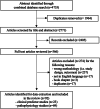Predictors and Pathophysiology of Axial Postural Abnormalities in Parkinsonism: A Scoping Review
- PMID: 38026508
- PMCID: PMC10654876
- DOI: 10.1002/mdc3.13879
Predictors and Pathophysiology of Axial Postural Abnormalities in Parkinsonism: A Scoping Review
Abstract
Background: Postural abnormalities involving the trunk are referred to as axial postural abnormalities and can be observed in over 20% of patients with Parkinson's disease (PD) and in atypical parkinsonism. These symptoms are highly disabling and frequently associated with back pain and a worse quality of life in PD. Despite their frequency, little is known about the pathophysiology of these symptoms and scant data are reported about their clinical predictors, making it difficult to prompt prevention strategies.
Objectives: We conducted a scoping literature review of clinical predictors and pathophysiology of axial postural abnormalities in patients with parkinsonism to identify key concepts, theories and evidence on this topic.
Methods: We applied a systematic approach to identify studies, appraise quality of evidence, summarize main findings, and highlight knowledge gaps.
Results: Ninety-two articles were reviewed: 25% reported on clinical predictors and 75% on pathophysiology. Most studies identified advanced disease stage and greater motor symptoms severity as independent clinical predictors in both PD and multiple system atrophy. Discrepant pathophysiology data suggested different potential central and peripheral pathogenic mechanisms.
Conclusions: The recognition of clinical predictors and pathophysiology of axial postural abnormalities in parkinsonism is far from being elucidated due to literature bias, encompassing different inclusion criteria and measurement tools and heterogeneity of patient samples. Most studies identified advanced disease stage and higher burden of motor symptoms as possible clinical predictors. Pathophysiology data point toward many different (possibly non-mutually exclusive) mechanisms, including dystonia, rigidity, proprioceptive and vestibular impairment, and higher cognitive deficits.
Keywords: Antecollis; Camptocormia; Parkinsonisms; Pisa syndrome; axial postural abnormalities; clinical predictors; pathophysiology.
© 2023 The Authors. Movement Disorders Clinical Practice published by Wiley Periodicals LLC on behalf of International Parkinson and Movement Disorder Society.
Figures
References
-
- Doherty KM, van de Warrenburg BP, Peralta MC, Silveira‐Moriyama L, Azulay JP, Gershanik OS, Bloem BR. Postural deformities in Parkinson's disease. Lancet Neurol 2011;10(6):538–549. - PubMed
-
- Ashour R, Jankovic J. Joint and skeletal deformities in Parkinson's disease, multiple system atrophy, and progressive supranuclear palsy. Mov Disord 2006;21(11):1856–1863. - PubMed
Publication types
Grants and funding
LinkOut - more resources
Full Text Sources


